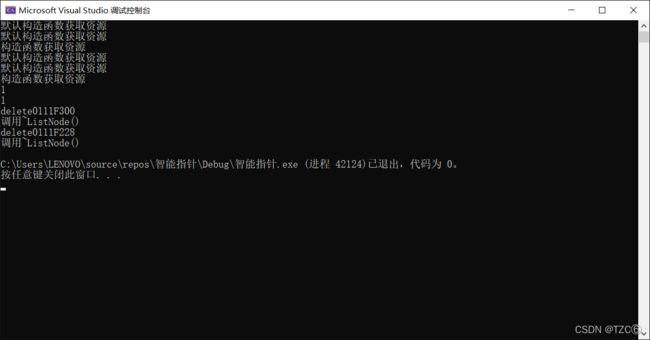C++智能指针
智能指针
-
- RAII
- 智能指针
-
- ①auto_ptr
- ②unique_ptr
- ③share_ptr
-
- 循环引用
- ④weak_ptr
- 定制删除器
RAII
RAII(Resource Acquisition Is Initialization)是一种利用对象生命周期来控制程序资源的简单技术。
在对象构造时获取资源,接着控制对资源的访问使之在对象的生命周期内始终保持有效,最后在对象析构的时候释放资源
我们实际上把管理一份资源的责任托付给了一个对象。这种做法有两大好处:
1.不需要显式地释放资源
2.采用这种方式,对象所需的资源在其生命期内始终保持有效
典型的应用有智能指针和lock_guard
智能指针
智能指针除了具有RAII特性外,还需要像指针一样去使用它,所以还需要重载operator*与->
#include
总结一下智能指针的原理:
1. RAII特性
2. 重载operator*和opertaor->,具有像指针一样的行为
此时智能指针如果调用默认生成的拷贝构造会发生浅拷贝,会释放两次资源
如果使用深拷贝就失去指针拷贝的意义了,必须要让指针指向同一块空间
所以如何解决这个拷贝问题就诞生除了不同类型的智能指针
①auto_ptr
C++98推出的auto_ptr解决拷贝问题是通过管理权的交接,每拷贝一次管理权就交接一次,让最后一个拷贝的智能指针释放资源
#include
所以auto_ptr导致原来的智能指针不能访问资源,并不能够很好地解决问题,不推荐使用
C++11后为了解决该问题推出了其他的智能指针
②unique_ptr
unique_ptr是通过简单,粗暴地禁止拷贝来解决
namespace tzc
{
template<class T>
class unique_ptr
{
public:
unique_ptr(T* ptr)
:_ptr(ptr)
{
cout << "构造函数获取资源" << endl;
}
T& operator*()
{
return *_ptr;
}
T* operator->()
{
return _ptr;
}
unique_ptr(const unique_ptr<T>&)=delete ;
unique_ptr<T>& operator=(unique_ptr<T>&) = delete;
~unique_ptr()
{
if (_ptr != nullptr)
{
delete _ptr;
cout << "析构函数释放资源" << endl;
}
}
public:
T* _ptr;
};
};
int main()
{
tzc::unique_ptr<string> sp1(new string("hello world"));//将资源托管给sp
tzc::unique_ptr<string> sp2(sp1);//禁止拷贝
cout << sp1->c_str() << endl;
return 0;
}
③share_ptr
shared_ptr的原理:是通过引用计数的方式来实现多个shared_ptr对象之间共享资源
具体解决拷贝问题:
1.shared_ptr在其内部,给每个资源都维护了着一份计数,用来记录该份资源被几个对象共享
2. 在创建对象是把引用计数初始化为1,在对象被销毁时,对象的引用计数减一,拷贝或者赋值时计数加一
3. 当引用计数是0,就说明自己是最后一个使用该资源的对象,必须释放该资源,否则就不用释放
引用计数必须让该对象的拷贝或赋值的对象能够拿到同一份计数:
如果使用静态成员变量,在模板中,同一个类共用一份计数,还是无法解决,而通过维护一个在堆上开辟空间的指针就能够让其指向同一份空间,第一个对象开辟空间,而拷贝,赋值则将该空间的指针进行拷贝,并将该指针指向的计数++或者–即可
namespace tzc
{
template<class T>
class shared_ptr
{
public:
shared_ptr(T* ptr=nullptr)
:_ptr(ptr)
,_count(new int(1))
,_mutex(new mutex)
{
cout << "构造函数获取资源" << endl;
}
T& operator*()
{
return *_ptr;
}
T* operator->()
{
return _ptr;
}
shared_ptr(const shared_ptr<T>& sp)
:_ptr(sp._ptr)
,_count(sp._count)
,_mutex(sp._mutex)
{
AddRef();
}
shared_ptr<T>& operator=(shared_ptr<T>& sp)
{
//管理的是同一份资源不处理
if (_ptr !=sp._ptr )
{
ReleaseRef();
_count = sp._count;
_ptr = sp._ptr;
_mutex = sp._mutex;
AddRef();
}
return *this;
}
~shared_ptr()
{
ReleaseRef();
}
public:
T* _ptr;
int* _count;
mutex* _mutex;//保证线程安全
private:
void AddRef()
{
_mutex.lock();
++(* _count);
_mutex.unlock();
}
void ReleaseRef()
{
_mutex.lock();
int flag = 0;
if (--(*_count) == 0)
{
if(_ptr)
{
cout << "delete" << _ptr << endl;
delete _ptr;
}
delete _count;
flag = 1;
}
_mutex.unlock();
if (flag == 1)
{
delete _mutex;
}
}
};
};
int main()
{
tzc::shared_ptr<string> sp1(new string("hello world"));//将资源托管给sp
tzc::shared_ptr<string> sp2(sp1);
cout << *(sp1._count) << endl;
return 0;
}
循环引用
在如下场景:如果我们用shared_ptr来管理,就会造成循环引用
struct ListNode
{
tzc::shared_ptr<ListNode> _next;
tzc::shared_ptr<ListNode> _prev;
int _val;
~ListNode()
{
cout << "调用~ListNode()" << endl;
}
};
int main()
{
tzc::shared_ptr<ListNode> node1(new ListNode);
tzc::shared_ptr<ListNode> node2(new ListNode);
// 循环引用
node1->_next = node2;
node2->_prev = node1;
// ...
//delete node1;
//delete node2;
return 0;
}

由于_count一直为1,智能指针也不会delete释放掉管理的资源,会导致没有调用ListNode的析构函数,造成内存泄漏问题
那如何解决循环引用问题呢——weak_ptr
④weak_ptr
weak_ptr有点像shared_ptr,只是weak_ptr不会增加引用计数
template<class T>
class weak_ptr//不参与资源的管理 不delete shared_ptrdelete
{
public:
weak_ptr(const shared_ptr<T>& sp)
:_ptr(sp.get())
{
cout << "构造函数获取资源" << endl;
}
weak_ptr()
:_ptr(nullptr)
{
cout << "默认构造函数获取资源" << endl;
}
T& operator*()
{
return *_ptr;
}
T* operator->()
{
return _ptr;
}
weak_ptr<T>& operator=(shared_ptr<T>& sp)
{
//管理的是同一份资源不处理
_ptr = sp.get();
return *this;
}
T* get()const
{
return _ptr;
}
int use_count()
{
return *_count;
}
private:
T* _ptr;
int* _count;
mutex* _mutex;
//保证线程安全
private:
};
};
struct ListNode
{
tzc::weak_ptr<ListNode> _next;
tzc::weak_ptr<ListNode> _prev;
int _val;
~ListNode()
{
cout << "调用~ListNode()" << endl;
}
};
int main()
{
tzc::shared_ptr<ListNode> node1(new ListNode);
tzc::shared_ptr<ListNode> node2(new ListNode);
// 循环引用
node1->_next = node2;
node2->_prev = node1;
// ...
cout << node1.use_count() << endl;
cout << node2.use_count() << endl;
return 0;
}

weak_ptr不会增加shared_ptr管理资源的引用计数,也不会参与资源的管理(shared_ptr管理),但可以像指针一样去使用
在这种shared_ptr搭配weak_ptr使用下,出作用域局部变量shared_ptr析构计数由一置零,会调用delete ptr,释放资源,实现类释放的同时,其成员变量也一并释放
定制删除器
由于智能指针析构用的是delete ptr,所以有些类型无法支持,例如开辟的数组对象,打开文件等等,此时需要传入可调用对象来定制删除
template<class T>
struct DelArr
{
void operator()(const T* ptr)
{
delete[] ptr;
}
};
// 定制删除器 -- 删除器控制释放资源的方式
int main()
{
std::shared_ptr<ListNode> spArr(new ListNode[10], DelArr<ListNode>());
std::shared_ptr<FILE> spfl(fopen("test.txt", "w"), [](FILE* ptr){
cout << "fclose:" << ptr << endl;
fclose(ptr);
});
return 0;
}


